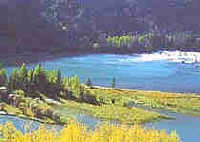| |
Kanas Lake
( 2005-09-13 )
 In July or August, standing at the Fish ViewingPavilionthat is 2,030 m above sea level, and looking down at the view below, visitors will be attracted by the beautiful lake and its surrounding areas of grand glaciers, gurgling streams, and verdant forests and pastures. Visitors will find that under the blue sky and white clouds the lake surface is just like a beautiful large color canvas, whose color varies: some parts are heavy in color, some are light, some are blue, and some are green. In July or August, standing at the Fish ViewingPavilionthat is 2,030 m above sea level, and looking down at the view below, visitors will be attracted by the beautiful lake and its surrounding areas of grand glaciers, gurgling streams, and verdant forests and pastures. Visitors will find that under the blue sky and white clouds the lake surface is just like a beautiful large color canvas, whose color varies: some parts are heavy in color, some are light, some are blue, and some are green.
The Kanas Lake is actually made up of six gulfs. At present, only three sections of the lake are open to tourists. In the Kanas Lake, tourists can view "Treasure Light," which is called "Buddha Light" by local people. The light, when integrated with the beautiful Kanas Lake view, the white glaciers, the green grassland, the boundless forest, and the mist in the mountains, will make people feel as if they were in a fairyland.
When the sun rises in the morning or at the time it is getting dark after sunset, when on a boat on the lake or standing on the platform at the lake center, if lucky, people can see the mysterious "lake monster" like a small boat, appearing or disappearing.
The legendary lake monster gives Kanas more mystery and color. It is said that an enormous monster has been living in the lake since ancient times, which often stirred high water sprouts and sometimes dragged horses, cattle, and sheep into the water. In recent years, scientists and explorers have been lured here in search of the truth about the monster, but no hard evidence has yet been collected. Some scientists assume that the monster could just be a rare, if outlandish, species of fish.
Kanas is the only outstretched belt of Siberian Taiga Forest in China, the only distribution area of Siberian plants in China, and the largest branch river head of the Irtysh River (or Etix River in Kazak language) -- the only water system to the Arctic Ocean in China. It is also the only place in China inhabited by Mongolian Chinese -- Tuwa people, and the place of the alpine glacier with the smallest altitude in China.
Tuwa people, also called "Tuwa," "Dewa," or "Kukumenqiak," have a long history and were recorded in ancient literature. Some scholars hold the view that Tuwa people are the offspring of the old, weak, sick, and disabled soldiers left byGenghis Khanwhen he led his troops to attack the Western Regions. But Tuwa elders said that their ancestors migrated from Siberia 500 years ago, and that they are the same ethnic group as the Tuwa people of the Tuwa Republic of Russia.
Tuwa people have kept their unique custom and language. Tuwa language falls into the Turkic language group of the Altaic language family and is closely related to the Kazak language. Tuwa people celebrate the traditional MongolianAobaoand Zoulu (Winter) festivals as well as the Han people's Spring andLantern festivals. Tuwa people believe inBuddhismand live in Tuwa Village, Biahaba Tuwa Village, and so on around Kanas.
The Kanas Lake and Tuwa people, in a harmonious union, constitute a unique view and folk culture at Kanas.
|
|

